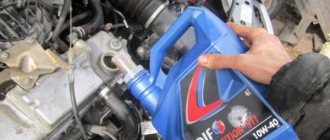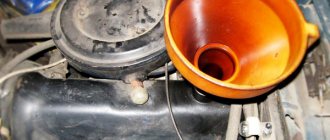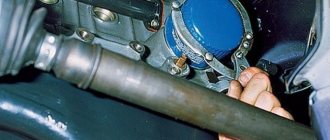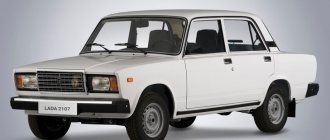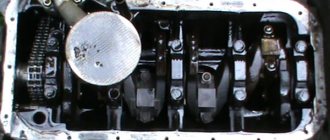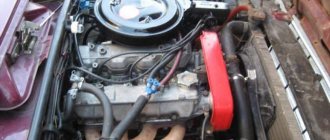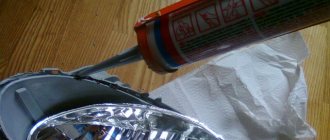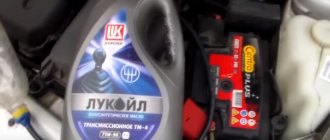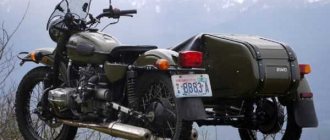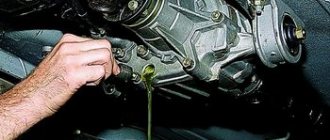The topic of the article is oil in the field. The general article on oils was written in 2011 and since then, of course, a lot of water has passed under the bridge and a lot of new information has appeared. This story will be written for the Nivov site, taking into account my experience with these engines. To avoid unnecessary questions, I will say right away that I do not work with Russian oils. Because in the fields of chemistry and petrochemistry we have a serious lag. There are decent individual products (Lukoil, Tatneft), but in terms of price-quality ratio, and most importantly the stability of different plants, “alas and ah.”
Engine VAZ 21214 1.7l
Changing engine oil is an essential component of proper operation of any car.
Timely replacement of the working fluid and oil filter allows you to maintain the engine in optimal condition, ensuring its long-term and trouble-free operation. Therefore, the owners of this domestically produced SUV have a logical question about what kind of oil to pour into the Niva 21214 with an injector, how much is required, and how to carry out the replacement procedure yourself. Selecting oil for Niva 21214 is not so difficult. But here you need to know some nuances in order to avoid common mistakes. Let's start with the time of year. Not every car owner knows what kind of oil to pour into the engine of his Niva if it’s summer or winter outside. In summer the weather is hot, so passenger car engines get very hot under such conditions.
“Niva 21214” is an all-wheel drive SUV, and its engine warms up even more. That’s why many people make the same mistake, filling in mineral or semi-synthetic oil for the summer. To ensure that the engine runs efficiently and does not overheat, experts recommend using high-quality synthetics.
If the lubricating fluid in the power unit has an insignificant percentage of viscosity, you should not expect the expected effect from it. When the cylinder block heats up, such oils have a consistency similar to ordinary water and their temperature rises rapidly. Therefore, the lubricant will no longer take heat from the engine, performing a cooling function, and will also not be able to create the required pressure. Operating in this mode will lead to rapid jamming of the crankshaft.
Therefore, the manufacturer and experienced car owners themselves advise filling the Niva engine, as well as the Chevy Niva (Chevrolet) engines, with motor oils with a viscosity of 20W40, but not higher than 25W50. These are the optimal viscosity parameters at which the crankshaft can function normally and not create unnecessary load.
- very liquid (otherwise an ice film will form from the cold);
- too thick (otherwise the crankshaft will not be able to rotate when starting a cold engine).
For winter, it is better to fill the engine with oil that meets the viscosity parameters of at least 0W40 and maximum 0W50. By pouring such liquid into the engine in winter, when the temperature drops to a maximum of -40 degrees, the starter can easily cope with cranking. The viscosity is not very high, and even low temperatures will not prevent the engine from starting.
Avoid semi-synthetic oils. Yes, such mixtures can be expensive and have similar characteristics to synthetics. But even the high price and identical labels on the packaging do not allow semi-synthetics to obtain the same properties that synthetic oils have.
The Niva SUV, in all modifications, is very popular in Russian spaces. This is due to good maintainability, low price and excellent maneuverability. To ensure reliable operation, you should undergo all maintenance on time, in particular, change the engine oil.
The VAZ 21214 engine lubrication system is designed to protect against premature wear of moving parts. It completely copes with its task, you just need to follow all the manufacturer’s recommendations.
Changing the engine oil is a regulated maintenance procedure, which is prescribed in the operating instructions. There is nothing complicated about it if you clearly and carefully follow the described action plan.
Our most popular engines are injection and carburetor engines, with a volume of 1.7 and 1.6 liters. The replacement process on these engines, as well as other modifications, will be the same.
To refuel and service a domestic VAZ SUV, you need to know the filling capacities of the VAZ 21213 Niva and its modifications, the VAZ 21214. Some numbers need to be known by heart, for example, the capacity of the tank and engine crankcase. The rest should be written down in a notepad, which is stored in the glove compartment of the cabin.
The VAZ 21214 engine was conceived as the first injection engine for a domestic SUV. The Niva was not particularly popular in the USSR, but was exported to Asia, the UK, Europe, Latin America and the USA. During production since 1994, there have been several improvements and modifications of the internal combustion engine from Euro-0 to Euro-5 (export).
It is believed that the basis of the ICE 21214 was the previous version 21213. In fact, ¾ of the parts in the engine
- the engine layout has changed - an injector instead of a carburetor;
- additional attachments appeared - DPKV, DXX sensor, Bosch MP 7.0 controller;
- crankshaft with a long crank radius of 40 mm, not used in previous AvtoVAZ engines;
- Cylinder head with holes for phase sensor and receiver studs, hydraulic supports for valve levers instead of adjusting bolts.
| Manufacturer | AvtoVAZ |
| Engine brand | 21214 |
| Years of production | 1994 – … |
| Volume | 1690 cm 3 (1.7 l) |
| Power | 59.5 kW (81 hp) |
| Torque moment | 127.5 Nm (at 4000 rpm) |
| Weight | 122 kg |
| Compression ratio | 9,3 |
| Nutrition | injector |
| Motor type | in-line |
| Injection | distributed electronically controlled |
| Ignition | modular |
| Number of cylinders | 4 |
| Location of the first cylinder | TVE |
| Number of valves on each cylinder | 2 |
| Cylinder head material | aluminum alloy |
| Intake manifold | duralumin |
| An exhaust manifold | cast iron or welded steel |
| Camshaft | original cam profile |
| Cylinder block material | cast iron |
| Cylinder diameter | 82 mm |
| Pistons | from 21213 |
| Crankshaft | from 21213 |
| Piston stroke | 80 mm |
| Fuel | AI-92 |
| Environmental standards | Euro-2/3 |
| Fuel consumption | highway – 8.3 l/100 km combined cycle 10.5 l/100 km city – 11.5 l/100 km |
| Oil consumption | maximum 0.7 l/1000 km |
| What kind of oil to pour into the engine by viscosity | 5W30, 5W40, 10W40, 15W40 |
| Which engine oil is best by manufacturer | Liqui Moly, LukOil, Rosneft, Mannol, Mobil |
| Oil for 21214 according to composition | synthetics, semi-synthetics, mineral |
| Engine oil volume | 3.75 l |
| Operating temperature | 95° |
| ICE resource | declared 80,000 km actual 160,000 km |
| Adjustment of valves | hydraulic compensators |
| Cooling system | forced, antifreeze |
| Coolant volume | 7.8 l |
| water pump | with plastic impeller |
| Candles for 21214 | BCPR6ES from NGK or domestic AU17DVRM |
| Spark plug gap | 1.1 mm |
| Timing drive | single row chain |
| Cylinder operating order | 1-3-4-2 |
| Air filter | Nitto, Knecht, Fram, WIX, Hengst |
| Oil filter | with check valve |
| Flywheel | from 21213 with clutch bore diameter 200 mm or 215 mm |
| Flywheel mounting bolts | M12x1.25 mm, length 26 mm |
| Valve stem seals | manufacturer Goetze, light inlets, dark exhausts |
| Compression | from 12 bar, difference in adjacent cylinders maximum 1 bar |
| XX speed | 800 – 850 min -1 |
| Tightening force of threaded connections | spark plug – 31 – 39 Nm flywheel – 62 – 87 Nm clutch bolt – 19 – 30 Nm bearing cap – 68 – 84 Nm (main) and 43 – 53 (rod) cylinder head – three stages 20 Nm, 69 – 85 Nm 90° 90° |
Initially, the 21214 engine was developed for distributed injection, that is, for an injector. It was planned to ensure an environmentally friendly standard, which was carried out successfully - during the finalization process, the internal combustion engines had Euro-2 - Euro-4, and for the export versions of Niva and Nadezhda, even Euro-5.
The main feature of 21214 was the factory boost:
- injector instead of carburetor;
- modified cylinder head (hydraulic pushers);
In turn, this required improvement of other designs:
- the volume of engine oil has increased, the pump sprocket now has 30 teeth to increase its performance;
- the double-row chain is replaced by a roller-type single-row modification to drive attachments and the timing camshaft;
- The camshaft cams have changed shape.
Upgraded chain tension system:
- the spring creates pre-tension when the engine is off;
- After starting, pressure is created in the system, the tension is regulated by hydraulics.
The manufacturer has provided additional tuning with your own hands due to the 50 hp potential built into the design. With. Overhauling the simplest internal combustion engine design does not cause any problems, including in a garage on your own.
To work you will need:
- Oil.
- New oil filter.
- To drain the waste - a container.
- Flashlight.
- Wrenches.
- Puller for removing the filter.
Operation procedure:
- The car is mounted on an overpass and can be lifted on a lift.
- The dipstick is pulled out from the filler neck.
- The mudguard that protects the engine is removed.
- A container is placed to drain the waste. For Niva, its volume must be at least three liters.
- The drain plug is unscrewed. Its location is shown in the photo.
Location of the VAZ 2121 engine drain plug
- Oil is drained.
- The filter is removed. If necessary, a puller is used.
Removing the oil filter
- A little fresh oil is poured into the new filter.
- The sealing rubber of the filter is lubricated with the same composition.
- The device is installed in place. It twists about half a turn after the rubber band touches the cylinder block. You can see how to do this correctly in the video.
- Oil is poured into the engine through the neck.
- Check the level of the filled liquid using the marks.
- The engine starts and runs until the oil pressure light goes out.
- If necessary, lubricating fluid must be added.
- Check the tightness of the filter installation.
Also interesting: Liquids used and filling volumes Niva VAZ 21213, 21214, 2131 lada 4×4
Characteristics of motor 21213
The requirements for an SUV engine at the time of design were:
- increase power and torque, at least at medium speeds;
- ensure acceptable fuel consumption within 12 l/100 km;
- provide a basis for injection modification in the future.
The engine uses a crankshaft with a “long” crank radius and 82 mm cylinders. If the gas distribution mechanism drive breaks, it bends the valves, but at 3000 rpm the torque is 126 Nm, and the power is increased to 81 hp. With. Factory tuning used a modernized attachment - a Solex carburetor, and increased volumes of combustion chambers.
| Manufacturer | AvtoVAZ |
| Engine brand | 21213 |
| Years of production | 1994 – … |
| Volume | 1690 cm 3 (1.7 l) |
| Power | 61 kW (82 hp) |
| Torque moment | 126 Nm (at 3000 rpm) |
| Weight | 117 kg |
| Compression ratio | 9,3 |
| Nutrition | Solex carburetor |
| Motor type | in-line |
| Ignition | distributor |
| Number of cylinders | 4 |
| Location of the first cylinder | TVE |
| Number of valves on each cylinder | 2 |
| Cylinder head material | aluminum alloy |
| Intake manifold | duralumin |
| An exhaust manifold | cast iron |
| Camshaft | original cam profile |
| Cylinder block material | cast iron |
| Cylinder diameter | 82 mm |
| Pistons | original |
| from 2103 | |
| Piston stroke | 80 mm |
| Fuel | AI-92 |
| Environmental standards | Euro-0 |
| Fuel consumption | highway – 8.3 l/100 km mixed cycle 10.5 l/100 km city – 11.5 l/100 km |
| Oil consumption | maximum 0.7 l/1000 km |
| What kind of oil to pour into the engine by viscosity | 5W30, 5W40, 10W40, 15W40 |
| Which engine oil is best by manufacturer | Liqui Moly, LukOil, Rosneft |
| Oil for 21213 according to composition | synthetic in winter, semi-synthetic in summer |
| Engine oil volume | 3.75 l |
| Operating temperature | 95° |
| ICE resource | declared 80,000 km actual 160,000 km |
| Adjustment of valves | nuts |
| Cooling system | forced, antifreeze |
| Coolant volume | 10.7 l |
| water pump | with plastic impeller |
| Candles for 21213 | BCPR6ES from NGK or domestic AU17DVRM |
| Spark plug gap | 1.1 mm |
| Valve train chain | double-row, from 2103 with a new tensioner shoe design |
| Cylinder operating order | 1-3-4-2 |
| Air filter | Nitto, Knecht, Fram, WIX, Hengst |
| Oil filter | with check valve |
| Flywheel | with clutch landing diameter 200 mm or 215 mm |
| Flywheel mounting bolts | M12x1.25 mm, length 26 mm |
| Valve stem seals | manufacturer Goetze, inlet light, exhaust dark |
| Compression | from 10 bar, difference in adjacent cylinders maximum 1 bar |
| XX speed | 750 – 800 min -1 |
| Tightening force of threaded connections | spark plug – 31 – 39 Nm flywheel – 62 – 87 Nm clutch bolt – 19 – 30 Nm bearing cap – 68 – 84 Nm (main) and 43 – 53 (rod) cylinder head – three stages 20 Nm, 69 – 85 Nm 90° 90° |
Also interesting: Engine tuning: Niva 4x4 - increasing power using common methods
Taking into account the year of manufacture (1994) and the low compression ratio (9.3 units), users filled in 92 gasoline, and the engine manufacturer recommended AI 91 - 93. Compliance with the environmental protocol has not yet been discussed, so the engine is considered Euro-0.
Replacement frequency
If you look at the official manual from the automaker represented by AvtoVAZ, you will see numbers there of 10 thousand kilometers. That is, the plant advises changing the working fluid in the power unit at least once every 10 thousand km. But you, as an experienced or novice car owner, must understand that the calculation is made based on average values.
- dirt and dust on roads;
- hilly terrain, bad roads;
- operation under constant loads (cargo transportation, driving with a trailer);
- use of cheap types of oils;
- low quality fuel;
- aggressive driving style;
- sudden climate changes, etc.
Because of this, the actual frequency of oil changes in the Niva is reduced by approximately 2 times compared to the recommended one; the consumable should be changed approximately every 5–6 thousand kilometers or once a year. Start from what comes first. This is the optimal period of time, since the oil is already beginning to wear out, but does not completely lose its physical and chemical properties.
The situation is similar with the oil filter. A standard filter element allows it to be used for 10 - 12 thousand kilometers. But the filter suffers from the same negative factors as the oil itself, since they are closely related. In theory, it can withstand 2 oil changes, but from the standpoint of engine safety, it is better to change the filter itself at each lubricant change. It's not that expensive.
According to the manufacturer's regulations, service replacements of engine oil for Niva 2121 and other modifications are carried out after 10,000 kilometers or at intervals of 1 year. But some car owners consider this interval to be a little too high, recommending that it be shortened taking into account operating conditions.
At the factory, Niva models are filled with oil from different suppliers. Most often this is Petro-Canada Supreme 10W-40 or Lukoil Genesis Advanced 10W-40. But for accurate information about what is poured into your car from the factory, you should contact the feedback system of AVTOVAZ PJSC. When applying, you must indicate the year and month of manufacture of the car.
Products from other manufacturers can be used as lubricating fluid. When choosing, it is recommended to pay attention to semi-synthetics with a viscosity of 10W-40. The following motor oils are most popular among model owners:
- Lada Professional 10W-40
- Shell Helix HX7 10W-40
- Total Quartz 7000 10W-40
When using this car in winter, you should select oil taking into account the climate zone, as well as the recommendations of AvtoVAZ. Viscosity 5W-40 will allow you to operate the car down to -30°C, and 0W-40 up to -35°C.
What kind of oil should I put in Niva 21214?
What kind of oil should I put in Niva 21214? Sooner or later, the car owner has to decide this issue. It's one thing to buy a car, and another thing to know what to do with it. Niva 21214 is no exception, which must be protected, “fed” and properly operated
Motor oil and technical fluids used to lubricate the main elements of the car are important.
What engine oil is best to fill in the Niva 21214 engine in the summer?
The first thing you need to know is what kind of oil is best to pour into the Niva 21214 engine in the summer. The oil is selected taking into account the ambient temperature.
- -20С +40С – SAE 15W-40;
- 25С +45С – SAE 10W-40;
- 30С +45С – SAE 5W-40;
- 25С +35С – SAE 10W-30;
- 30С +35С - SAE 5W-30.
It is recommended to change the oil every 10,000 kilometers or once a year.
What oil is better to fill in the automatic transmission (automatic transmission) of Niva 21214?
For those who are interested in what kind of oil is best to fill in the automatic transmission (automatic transmission) of Niva 21214, we remind you that the car is equipped with a manual transmission with manual shifting. It has five forward gears and one reverse gear. Forward gears are synchronized.
What kind of oil is poured into the mechanics at the factory (officials) in winter for Niva 21214?
Knowing what kind of oil is poured into the mechanics at the factory (officials) in winter for Niva 21214, the owner of this car will save himself from frequent repairs and unnecessary costs associated with replacing the gearbox. By purchasing oil that does not meet the requirements set by the manufacturer, drivers may face the problem of gearbox malfunction. Manufacturers fill Niva 21214 with gear mineral oil.
Owners of Niva 21214 note that after they replaced mineral oil with semi-synthetic or synthetic oil, the noise and vibration of the gearbox decreased.
Recommendations for choosing and replacing engine oil in the engine of the Niva VAZ 21214 car
Every car enthusiast should know by heart the maximum fuel capacity of his car. The fuel tank of the VAZ 21213 has a capacity of 42 liters, including reserve. The reserve refers to the amount of fuel remaining in the tank after the yellow warning light on the instrument panel turns on. The reserve amount is at least 5 liters. The car must be fueled with gasoline whose octane number is in the range of 91-93.
The car has a number of refueling tanks that the owner must monitor during operation:
- brake system with expansion tank, total capacity - 0.515 l;
- hydraulic clutch drive with expansion tank - 0.2 l;
- 2 plastic tanks with a volume of 2 liters each contain a supply of windshield and rear window washer fluid.
The clutch release drive and brake system are filled with hydraulic brake fluid (the most popular is DOT-4). It should be changed at least every 3 years, because the liquid has the ability to absorb water vapor contained in the air. As a result, all steel parts of the system in contact with it begin to corrode, which leads to complete or partial failure of the brakes.
If there is a leak in the clutch or brake system, the level in the expansion tanks decreases, so constant monitoring is required over them.
Liquid or clean water for washing glass is added if necessary; in winter, a non-freezing option is required. Otherwise, the ice will not only destroy the tubes, but also damage the electric pump.
Various thick lubricants are also used for maintenance and lubrication of the Niva:
- Litol - a composition for lubricating highly loaded bearing parts;
- CV joints-4 - lubricant for the hinges of the front axle shafts and door opening limiters;
- ShRB-4 is designed for processing ball joints and steering rods.
The list of refueling containers is useful for novice car enthusiasts who bought a used car with a lost instruction manual. The operation of such a car should begin with the replacement of all fluids and oils.
The most important characteristic that you need to pay attention to when choosing a lubricant is its viscosity. If we are talking about oil, the composition must meet the requirements of international quality standards SAE J306. This type of certification was developed in the USA and is generally accepted today.
When deciding which oil to pour into Niva axles and other components, you need to evaluate the viscosity of the composition. According to the standards, the letter “W” corresponds to this indicator. As a rule, such a symbol is indicated on seasonal compositions. If there is a letter “W” on the package, this indicates that the liquid can be used in winter. In the absence of this symbol, oil may only be used in positive ambient temperatures.
Based on this, many believe that seasonal lubricants are much better. However, this is not quite true. The fact is that when operating any car, you need to change the oil even before it has exhausted its service life. Therefore, you should not be happy if the composition does not change its characteristics throughout the year.
All-season formulations are also on sale. These are the so-called thickened oils. They have the characteristics of both summer and winter lubricants.
It is equally important to pay attention to the performance properties of oils. In this case there are also certain standards (APIs). Also, when deciding what kind of oil to pour into the Niva, it is worth considering its composition.
Of course, it is logical to assume that the more natural the composition, the better it will be. This fact is confirmed by the unique properties of oils of this type. When using mineral compounds, contacting parts will deteriorate much more slowly. In addition, the so-called natural compounds have excellent anti-corrosion properties.
There are also those car owners who believe that mineral oils are not able to cope with heavy loads. But it is worth considering that during the internal combustion process, many mineral deposits are formed in the engine, which negatively affect the operation of the power unit. Mineral oils may indeed not be able to cope with serious “build-ups” of burnt particles. However, if we are talking about a car with low mileage, then “mineral water” will be quite enough.
Also, when choosing which oil to pour into the Niva transfer case or car engine, it is worth considering that mineral compounds cannot be used in the cold season. This is explained by the fact that this type of lubricant composition begins to thicken greatly at temperatures below -15 degrees. Because of this, the mechanisms cannot function normally. The use of such oils may result in the power unit having to warm up much longer.
Another disadvantage of mineral compositions is that they sometimes fade. Accordingly, the lubricating characteristics of the liquid decrease. This will lead to the components starting to wear out much faster, and fuel consumption will increase. In rare cases, even damage to the power unit may occur. Thus, it is recommended to use mineral-type compounds only at not very low temperatures and for cars with low mileage.
Also interesting: Design of the injection engine Niva 2121, Niva 2131
It is also worth considering that everything depends on the specific car. If one car owner praises the composition that he has been using for a long time for a Mercedes, this does not mean that the same oil is suitable for a Niva. As a rule, it becomes possible to understand that a particular composition is not suitable after 5000 km traveled by the car.
An important point is how often the composition is replaced. For example, if the car is used as a towing vehicle, often drives off-road and operates the power unit in the most difficult conditions, then the lubricant needs to be changed much more often.
Design Features
First of all, it is worth noting that gearbox fluids, even if they are “scorched,” cannot have such a destructive effect. If you choose a low-quality composition for the engine, the consequences will be much more serious.
It is also worth considering that everything depends on the specific car. If one car owner praises the composition that he has been using for a long time for a Mercedes, this does not mean that the same oil is suitable for a Niva. As a rule, it becomes possible to understand that a particular composition is not suitable after 5000 km traveled by the car.
An important point is how often the composition is replaced. For example, if the car is used as a towing vehicle, often drives off-road and operates the power unit in the most difficult conditions, then the lubricant needs to be changed much more often.
When choosing engine oil, consider the following. You should look for the API designation on every canister you decide to purchase. It will consist of a rating for gasoline cars (starting with S), and diesel engines (starting with C). These letters are followed by the corresponding letter depending on the age of the oil and the standards to which it meets.
More detailed information about which engine oil to use for the VAZ 21214 engine was found in the manual for the maintenance, operation and repair of the Niva 21213 car and its modifications (Kosarev, Yametov, Volgin, Kozlov). This edition contains the following titles:
- "LUKOIL - Arctic" (5W-30, 5W-40; SG/CD);
- “Yar-Marka Super” (5W-30, 5W-40; SG/ CD);
- "ESSO ULTRA" (10W-40; SJ/SH/CD);
- "ESSO UNIFLO" (15W-40; SJ/SH/CD);
- "Hovoil Sint" (5W-30; SG/CD);
- "REXOL UNIVERSAL" (10W-30, 10W-40, 15W-40, 20W-40, 30; SF/CC);
- "UFALYUB" (15W-40; SF/CC);
- "UFALYUB-LUX" (10W-30, 15W-40; SF/CC);
- "ANGROL" (10W-30; SF/CC);
- "NORSI" (10W-30, 10W-40, 15W-40, 20W-40; SF/CC);
- "YAR-MARKA 1 and 2" (10W-30, 15W-40; SF/CC);
- “YAR-MARKA EXTRA” (5W-30, 5W-40; SF/CC);
- "SAMOIL" (10W-30, 15W-40, 20W-40; SF type);
- "VELS 1" (10W-30; SF/CC);
- “LUKOIL-STANDARD (or WELS-2)” (10W-30; SF/CC);
- "LUKOIL STANDARD" (10W-30, 15W-40; SF/CC);
- "NOVOIL MOTOR" (15W-30);
- "OMSKOIL M" (10W-30; SF/CC);
- "SPECTROL" (10W-30, 15W-40; SF/CC);
- "VOLNEZ M" (20W-30; SF/CC);
- "FERGANOL" (30; SF/CC);
- "NAFTAN MB" (15W-40; SF);
- "SHELL HELUX" (10W-40; SF/CC);
- "AGIP SUPERMOTOROIL" (10W-30, 15W-40; SF/CC);
- “76 SUPER MOTOR OIL” (5W-30,10W-30, 10W-40, 20W-50, 30, 40; SJ).
And also interesting: Niva VAZ 21213 engine: characteristics, malfunctions and tuning || Niva 1996 engine
And also interesting: Chevrolet Niva air conditioning - installation and repair The leaders among oils for Niva are:
- Lukoil Lux 10w-40;
- Rosneft Premium;
- Shell Helix Ultra.
The 21213 engine was created from the working version 2121, taking into account new developments for the VAZ 2107 engine, which were never completed. The main differences from the Niva internal combustion engine are:
- new design pistons;
- changing the parameters of the cylinder head and connecting rods;
- crankshaft modernization;
- camshaft modification;
- use of Solex carburetor modification 21073;
- improved lubrication system;
- original design of the chain tensioner shoe.
A detailed description of the components is contained in the manufacturer's manual. To reduce costs, designers mainly used parts of engines already in production that were already in mass production at the time of 1994:
- standard cylinder block, from 2103, height 214.58 mm, cylinder center distance 95 mm;
- crankshaft - taken from 2103 with a crank radius of 40 mm, equipped with additional counterweights, oil channels are drilled in the connecting rod journals, and their diameters are increased by 0.02 mm;
- the cylinder head was used from 21011, but the combustion chambers were enlarged (30 cm 3 each), the height was ground down to 111 mm;
- timing valve mechanism – used from 2101 without changes;
- Timing chain – bush-roller double-row from 2103.
Factory boost provided a power of 81 hp. s and a torque of 126 Nm, but the manufacturer left a potential of about 45 - 60 hp. With. At the same time, he recommends improving the intake and exhaust tracts with your own hands without boring the cylinders and turbocharging the engine.
Replacement instructions
It would be logical to find out how much oil is in the VAZ Niva 21214 engine and how much motor fluid is required to purchase. If we talk about the volume of liquid being filled, then for the Niva engine it is 3.75 liters. The actual volume of oil in the engine is usually less than that indicated in the vehicle's data sheet.
This is due to the fact that when draining the waste, some of the oil still remains in the system. It is almost impossible to clean the engine 100% on your own. You should take plenty of oil, but not much. It is better to take a 5 liter canister of high-quality lubricant. This will allow you to fill the full volume into the crankcase, plus periodically add it as the level changes.
To work, you will need to collect some materials and tools. This list includes:
- fresh motor oil in the right quantity;
- an empty container where the waste will be drained;
- funnel for filling;
- fuel filter;
- 12mm hex or 17mm wrench;
- puller for the oil filter (you can do without it);
- inspection hole;
- rags;
- lighting;
- overalls (gloves, closed shoes, thick clothing).
If you have everything ready, you can start working. Be sure to follow the instructions step by step, do not rush and do not try to unscrew or tighten anything by applying great force. Otherwise, you risk breaking some parts, which will lead to more expensive repairs. We begin the procedure for changing the engine oil, changing the filter at the same time.
- Place the car on an inspection hole to have easy access to the bottom where the oil pan is located. The engine should be warmed up first so that the oil acquires a more liquid structure and can easily drain from the sump.
- If you warmed up the engine at idle, wait a few minutes so that all the liquid drains down. You can still unscrew the filler plug in the engine compartment. This will allow the oil to come out from below faster.
- Carefully unscrew the drain plug. It comes in different types, so you will need a hexagon or wrench to dismantle it. Before you begin to unscrew the cap, place an empty container under it. Unscrew completely and let the oil drain. This will take about 10 – 15 minutes. Therefore, at the same time, work on the oil filter.
- If the oil comes out very dirty, then a lot of debris, chips and dirt will remain in the system. In this condition, it is recommended to flush the engine. To do this, use special additives, flushing mixtures or fresh oil.
- There are additives that you simply add to the filler neck while the old grease is still there, start the engine and let it run for a few minutes. Then they are jammed and everything is removed from the pan.
- The option with flushing oil or regular fresh engine oil looks different. First, the old fluid is drained, then the drain plug is closed, fresh oil is added, the engine is turned on and it runs at idle speed for 5 - 10 minutes. Now the pan plug is unscrewed again and drained. If the engine is heavily dirty, it is recommended to repeat the procedure 2–3 times. This takes a lot of oil, but it gives the engine new life.
- Only after complete washing is the old filter removed and a new one installed in its place. The filter is unscrewed with a puller, manually or with an improvised tool. The puller is the most convenient, but is not always available to the car owner. Be careful not to damage adjacent pipes and wiring. For safety reasons, it is better to remove the negative terminal from the battery.
- Clean the holes for the drain plug and the filter if there is dirt there. Otherwise, they may get into the fresh motor fluid.
- Before reinstallation, check the plug gasket and replace it if necessary. The filter seal is lubricated with oil, and engine fluid is filled to 50% of the volume of the new filter. Now you can install them in place.
- Make sure that the filter and plug are firmly in place and that there are no leaks through them.
- We move on to the engine compartment, where we use a funnel to pour fresh composition through the filler neck. Fill in about 3.5 liters first, since some of the oil remains in the system. Close the lid and run the engine at idle speed for 2 - 3 minutes.
- Turn off the engine and let the oil drain. Take the dipstick and check the level. A trace of the oil film should remain between o and “Max”. If the level is closer to the minimum value, open the lid again, add a little more lubricant and repeat the procedure.
When you start the car, the oil pressure light will come on. It's not scary, it always happens. The indicator will go out after a few seconds. Over the next few days, monitor how your Niva behaves. Check under the car for traces of fresh oil. Leaks may occur due to a poorly installed filter or drain plug. Tighten the connections and recheck the level.
Owners of the VAZ Niva 21214 car are advised to periodically monitor the oil level, add it as needed and react promptly if the liquid suddenly changes color, becomes cloudy, its consumption increases or the engine overheats. Signs like these indicate more than just a leak.
Synthetic oils
When deciding what oil to pour into the Niva, many come to the conclusion that artificial compounds have better characteristics. Synthetic formulations may actually be more beneficial. During the development of such oils, complex chemical processes are used, thanks to which the characteristics of the fluid can be adjusted.
If we talk about the advantages of synthetic compounds, it is worth considering that they remain resistant to thermal changes much longer and retain their original characteristics longer. In addition, lubricating fluids of this type contain additional additives that significantly improve the performance of the oils.
Synthetic oils begin to freeze only at -60 degrees. They do not oxidize or evaporate. At the same time, their lubricating index is quite high. In this case, you can actually make replacements much less frequently.
Such compositions are considered optimal for those cars that have a fairly high mileage, but at the same time they have been filled with “synthetics” for too long. Semi-synthetic compounds are changed with varying regularity. This depends on numerous factors. It is important to consider how often the vehicle is used, the condition of the vehicle's powertrain, etc.
However, no matter what kind of oil is poured into the Niva, you must always remember that the more often the lubricant composition is changed, the longer the vehicle will last. Based on all this, we can identify several liquids that are most popular among car owners.
To come in
Already have an account? Sign in.
Latest Visitors 0 users online
No registered user is viewing this page
Hi all. I would like to discuss the topic “Who pours what kind of oil into their Niva.” I fill myself with Shel semi-synthetic. But somehow this oil no longer suits me. It gets too dense to park on the street all night. Can anyone give me some advice?
It has an engine like a seven, and I have always filled mine with EssoUltron5W40 since new; its characteristics are ideal for both winter and summer. Now I poured it into the Niva, the original oil was also thickening + the freaks from the ASC do not change the oil but add it to the maximum. The transmission was filled with Shell.
This is the second year I've been pouring Xado 5W50 into the engine. the work has become smoother and quieter, although not immediately, but after 7 thousand. There is no waste, over 10,000 km it drops from max to min, well, sometimes I’ll add 200 grams, if long journeys happen at a speed of over 120. A week ago I arrived from Ukhta, there for two months I started it every day even at -40. on another field, the starter did not turn, the oil froze, but mine started, I just had to bring the battery into the house at night. I don’t particularly believe in the restorative properties of this oil, but it has a good base. The mileage is already under 200 thousand, the engine works like a clock, pah-pah, despite the turbine, which, as we know, does not have a very good effect on the resource.
"Lukoil Lux 10W-40"
Many, when choosing which oil to pour into the Niva, give preference to this particular composition. The lubricating fluid of this brand meets all the necessary requirements. Car owners trust the quality of these compounds, since this manufacturer has long established itself in the market.
"Lukoil Lux 10W-40" has a positive effect on the power unit and helps conserve energy. Many noted that these compounds help reduce fuel consumption. According to tests, this oil performs well in various extreme conditions.
"Dolphin Industry"
Car owners highlight the products of this company (or rather, the compositions “Lux Hit” and “Lux Best”), since only modern technologies and the latest developments are used in the production process of lubricating fluids.
If, when deciding which oil to pour into the Chevrolet Niva engine, you chose this particular composition, then you should pay attention to the fact that it contains molybdenum. This component causes mixed reviews, but most car owners note the excellent properties of this additive. It is believed that molybdenum reliably preserves the power unit and reduces fuel consumption.
Leaks and problems
The higher the mileage of the VAZ Niva, the more problems appear, as in principle with any car. Most often this is due to natural wear and tear of the engine, causing oil to burn. Although the manufacturer allows for a small consumption.
Also interesting: Niva VAZ 21213 engine: characteristics, malfunctions and tuning
There can be many reasons why an engine eats oil. And in each case they can be individual. But, over the years of the model’s existence, we can talk about the most common places where leaks occur.
If the breather is spewing or throwing oil, or if there is oil in the exhaust manifold, this may indicate a serious problem with the oil rings. In this case, you can try decoking with dimexide. But it is better to use special auto chemicals designed for these purposes.
A leak from under the valve cover may be due to a worn gasket. Sometimes simply replacing the gasket does not solve the problem. Since the cover itself may have significant curvature. Therefore, in some cases it will have to be replaced.
A white emulsion in the engine or on the oil filler cap may indicate condensation. This is a common occurrence when temperatures change from minus to plus, mainly in autumn or spring.
But if the emulsion is also observed on the dipstick, then this is already a sign of more serious problems. Most often we can talk about a broken cylinder block gasket. And in rare cases, a cracked cylinder head may be to blame.
Also, with this problem, you can find oil in the expansion tank. Sometimes, simply replacing the gasket is not enough. It may be necessary to grind the head itself, and this is completely different money for repairs.
All this is general information, which may manifest itself differently on each specific vehicle, since everyone’s operating modes are different. The same applies to leak locations; it is impossible to identify the cause from a distance.
"Rosneft"
You can also find products from this popular manufacturer on the market. If, when choosing which oil to pour into a Chevrolet Niva engine, the car owner decides to purchase this particular composition, then he can be sure that the liquid uses the newest and most effective additives that will preserve the power unit longer.
It is also worth noting that Rosneft products are suitable if the vehicle is operated in harsh conditions or in situations of serious temperature changes. Oil from this manufacturer is characterized by low consumption.
Power unit
The engine installed on the modern model of the Niva 21213 (214) car was inherited from its Soviet progenitor - the VAZ 2121, and in terms of fluid volumes they are almost identical:
- Liquid cooling system. Filled with antifreeze in an amount of 10.7 liters with a freezing point not higher than -40 ° C. The capacity of the interior heating radiator is also included in this volume.
- Crankcase. Motor oils are poured here, the brand of which depends on the operating conditions. Capacity: 3.75 liters, including oil filter filling.
| Lower limit of ambient temperature, °C | -20 | -25 | -25 | -30 | -30 | -15 | -35 | -30 |
| Upper limit of ambient temperature, °C | 45 | 35 | 45 | 35 | 45 | 45 | 25 | 30 |
| SAE lubricant viscosity grade | 15W-40 | 10W-30 | 10W-40 | 5W-30 | 5W-40 | 20W-40 | 0W-30 | 0W-40 |
When flushing the power unit during the process of replacing liquid lubricant, the same amount of flushing oil (3.75 l) is used, taking into account the size of the filter. Replacement is carried out after 8-12 thousand kilometers, depending on the quality of the oil. Flushing is usually performed after 3 engine lubricant changes. During operation, it is important to monitor the oil level in the engine crankcase using a special dipstick. If the level drops below the Min mark, it is urgent to add lubricant to the engine of the same viscosity as was previously filled.
Antifreeze needs to be updated at least once every 3 years or according to the degree of wear of the fluid. It is not recommended to dilute antifreeze with distilled water, either in winter or summer. In winter, the diluted liquid may freeze, and during the summer heat it may boil ahead of time, which will lead to overheating of the engine.
Oil according to weather
First of all, before choosing oil for Niva 21214, pay attention to the weather conditions, or more precisely, the time of year. For example, in the summer, when it is quite hot outside, the engine will heat up significantly
Unlike passenger cars, the engine of this car will heat up much more. Therefore, pouring mineral or semi-synthetic oil into an SUV engine in the summer is a big mistake.
Engine oil viscosity (SAE)
A lubricating fluid with a low percentage of viscosity will not have the desired effect. When the cylinder block is heated, the liquid takes on the state of ordinary water and also heats up very quickly. As a result, the oil stops taking away heat from the engine and creating the proper pressure. After some time of such work, the crankshaft will definitely jam.
For the summer period, it is recommended to pour motor oil into Niva 21214, the viscosity of which will be indicated at least 20W-40 and no more than 25W-50. This is the ideal viscosity at which the crankshaft will rotate freely without creating unnecessary load, and the engine temperature will not exceed 95 degrees.
In winter, more serious problems arise with the choice of oil. In this case, it should not be too thin, so that when exposed to cold it does not become covered with ice, and not too thick, so that when starting the engine in a cold state, the crankshaft can make the first revolution.
For Niva 21214, the most suitable oil is the viscosity of which will be no less than 0W-40 and no more than 0W-50. If you pour it into the engine in winter, at temperatures up to 40 degrees below zero, then the starter will have enough strength to crank the crankshaft, since the viscosity will not be too high, even despite the effects of cold. At the same time, even at lower temperatures, the liquid will not form an ice crust.
When choosing engine oil for Niva 21214, under no circumstances choose all-season oil. Although it seems economical in terms of the ratio of cost to operating conditions, problems may arise with it when starting the engine. It is best to pour either winter or summer oil, depending on the time of year. Also, do not use semi-synthetic oil. No matter how expensive it is, its properties will always be inferior to synthetic ones.
Transmission
The Niva 4x4 transmission system has the following filling volumes:
- transfer case - 0.79 l;
- gearbox - 1.6 l;
- rear axle - gearbox - 1.3 l;
- front axle - crankcase - 1.15 l;
- steering column - crankcase - 0.18-0.2 l.
| Lower limit of ambient temperature, °C | -15 | -25 | -25 | -30 | -40 |
| Upper limit of ambient temperature, °C | 45 | 45 | 35 | 45 | 35 |
| SAE lubricant viscosity grade | 85W-90 | 80W-90 | 80W-85 | 75W-90 | 75W-80 75W-85 |
As stated in the operating instructions, transmission lubricants need to be changed once every 30 thousand km. mileage At the same time, replacement is not provided for in the steering mechanism housing, only an addition through the top plug. The “native” oil for Zhiguli transmission units is considered to be TAD17I.
Transmission oils have good penetrating ability. Therefore, poorly clamped plugs and worn gaskets of units begin to gradually leak lubricant. In such situations, it is allowed to add oil of the same viscosity class and, preferably, the same manufacturer. If you do not top up during a leak, the lubricant level in the unit will decrease, which will lead to accelerated wear of expensive mechanisms.
What kind of oil and how many liquids to fill in a Chevrolet Niva
| Filling/lubrication point | Refill volume | Name of oil/liquid |
| Fuel tank | 58 liters | 95 petrol |
| Engine lubrication system (including oil filter) engines: | ||
| VAZ-2123 1.7 liters | 3.75 liters | type: Super SAE oil type: 5W30; 5W40; 10W30; 10w40; 15w40; 20w40, according to API: SG, SH, SJ, according to ASEA: A2 |
| Engine cooling system: | ||
| VAZ-2123 1.7 liters | 8 liters | Antifreeze based on ethylene glycol with a complex of corrosion inhibitors and defoamer |
| Transmission. | 1.6 liters | according to SAE: 75W-90; 80W-85; 80W-90, according to API GL-4 |
| Transfer case. | 0.79 liters | |
| Steering gear. | At your own discretion | according to SAE: 80W-90; 85W-90, according to API: GL-5 |
| Per. and back. Bridge. | 1.15 and 1.3 liters | |
| Power steering. | 1.7 liters | Pentosin Hydraulic Fluid CHF11S VW52137 |
| Brakes | 0.5 liters | Type DOT-4 SAEJ1703, FMSS116. |
| Clutch | 0.15 liters |
What is the best oil to fill into a VAZ-2114 engine 8 valve injector
Choosing engine oil is a responsible task on which the service life of the power plant depends. This procedure is no less important than the oil change process itself. Oil should be selected according to the parameters and tolerances specified in the operating instructions. You cannot make a mistake in your choice, as this mistake can result in a serious technical breakdown, and incompatible oil can cause a major engine overhaul
In this article, using the example of the popular Chevrolet Niva SUV, we will pay attention to the most important parameters of engine oil, and also consider the best brands of oils, and how much oil should be filled
How to change the oil in a VAZ 2121 engine
If we are talking about the Chevrolet Niva, the manufacturer recommends changing the oil every 15,000 km. In this case, manipulations must be carried out in accordance with the clear recommendations of specialists.
First of all, you need to place the car on a viewing hole or lift. When the car is secured and cannot accidentally move, you can remove the engine protective cover located at the bottom. After this, you need to place a container under the hole (a 5-liter canister is best) and unscrew the drain plug.
When the fluid is renewed, it is necessary to install the element in place of the old one. The next step is to replace the seal. After this, you can tighten the drain hole and return the protection to the engine.
Next, you need to open the neck and pour about 3.5 liters of lubricant into it. That's not all.
After all the manipulations, you need to start the car engine and wait until the power unit warms up. When a little oil is gone, add a little more compound and leave the engine running for another 10 minutes. After this, the oil level is checked again (it is best to use a special dipstick). If there is not enough liquid, you need to add it.
The oil in the VAZ 2121 gearbox is changed every five years or 75,000 kilometers of the car. The volume of fluid required is:
- Three liters for a four-speed gearbox.
- 3.3 liters – five-speed gearbox.
- Open-end wrenches.
- Hexagon.
- Syringe for filling oil.
- Container for draining waste.
The work is carried out in the inspection pit, the engine needs to be warmed up. Sequence of operations:
- Use a hexagon to unscrew the drain plug.
- Oil is drained.
- The plug is installed in place.
- The filler bolt located on the side of the device is unscrewed.
The filler bolt KP 2121 is unscrewed
- New oil is poured in using a syringe.
Filling oil into gearbox 2121
- The filler plug is installed.
- The drain plug is unscrewed with a hexagon to “12”.
Location of the drain plug
- Oil is draining from the device.
- The magnet is cleaned and the plug is screwed back in.
- The filler plug is removed.
- Using a syringe, oil is poured into the VAZ 2121 transfer case.
Filling oil into the transfer case of a VAZ 2121
- Check the fluid level. It should reach the bottom edge of the hole through which the oil is poured.
- The breather, which is located on the side of the rear cardan shaft, is cleaned of dirt.
Timely oil changes in the components of the VAZ 2121 car will increase the service life of the car in reliable condition.
Motor 21214 was used to equip several cars manufactured by AvtoVAZ:
- Lada Niva 4x4 (VAZ-21214) – three-door SUV;
- Lada 4x4 M - modernized version with power steering and ABS;
- Lada 4x4 5D (VAZ-213100) – an extended modification of a five-door SUV;
- “Ambulance” (VAZ-213145) – Euro-2/3 in small series;
- Lada Nadezhda (VAZ-2120) is a seven-seater all-wheel drive minivan.
The management did not consider it necessary to install it on the seven-seater Largus minivan. But in all modifications of the Niva 3- and 5-door (Bronto, Kedr, Pickup, Reka, Bys and armored collection vehicle) it was present.

